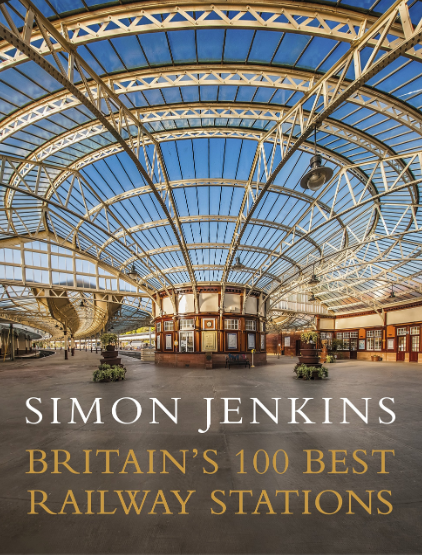Britain's 100 Best Railway Stations
Britain's 100 Best Railway Stations, Simon Jenkins, Penguin, 2017 (re-published 2021), 326 pages, hardback.
The steam railway was Britain’s gift to the world, and railways have shaped modern Britain in a way that canals and roads never could. From Rain, Steam and Speed to Harry Potter, trains have become part of our minds.
This well-written, nicely-produced book celebrates our railway stations, where journeys start and end, in 100 personal best examples (of a possible 2,560) chosen for ‘qualities of architectural beauty, eccentricity or setting’. Simon Jenkins is a respected author and columnist, among whose achievements has been his membership of the British Railways Board in 1979–1990. He founded the Railway Heritage Trust in 1984.
His book is essentially a well-illustrated list of stations, preceded by an introduction that provides a potted history of British railway developments. This is followed by a chapter on The Station in the British Imagination, which takes the reader on a delightful tour through the cultural landscape of railways. Turner, Ruskin, Betjeman, Auden, Larkin, Forster, JK Rowling are all here, along with Thomas the Tank Engine.
The list of 100 stations (each rated between one and five stars) follows. The stations are grouped into regions, with a good geographical spread, although London (not surprisingly) predominates. The chapter on London termini rejoices in nuggets of detail. Who knew that the Paddington-based Great Western Railway produced its own radishes, watercress and whisky, or that in 1970 a sleeper service was planned from Victoria to Moscow? Barlow’s great train shed at St Pancras (five stars) still impresses, Waterloo is still as busy as ever. London suburban stations follow, with the theatrical Battersea Park and the little-known Gants Hill (‘wow’, writes Jenkins) giving way to Peckham Rye with stern warnings against venereal disease in its Gents.
Jenkins’ descriptions are crisp and never boring. He includes the moderne Surbiton and the modern Southwark Underground, which gets four stars. Leaving the metropolis behind, the list heads south east, to French renaissance Slough with its Station Jim (a stuffed dog) and then south west, where Bath Spa’s Jacobean sits oddly with the Georgian city. The cottage style of Eggesford Station is aptly described as ‘mudstone picturesque’.
East Anglia comes with an eclectic mix of station architecture. Norwich is ‘France meets Russian princess’, Bury St Edmunds is ‘Wrennish baroque’. The list speeds on into the midlands, to the 2008 bling of Birmingham New Street’s concourse and away to the celebrated iron leaves of Great Malvern, the red-stoned Vanbrughian Nottingham and the sedate gothic of Shrewsbury, with its 180-lever signal-box.
The north west and north east follow. Carlisle, a town that was the scene of (literal) battles between rival railway companies, gets four stars for its Citadel Station in collegiate Tudor, with a Hogwarts bell-tower. Jenkins gives Liverpool Lime Street five stars. Manchester Liverpool Road, has the ‘oldest station platform in the world’ and Victoria has an amazing ‘Mancunian neo-baroque’ cafeteria.
Across the Pennines, Darlington has a magnificent clock that was wound and checked by a railway company clock man. Few provincial stations are as impressive, or as classical, as Huddersfield (four stars) and few have anything like the great curving trainshed roof of Newcastle Central. Newcastle Jesmond is curious; a ‘miniature homage’ to Mies van der Rohe. Tynemouth reads like shorthand for the seaside.
Wales has its own chapter. Welsh stations are often rural, low-key places, with the exception of the art-deco Cardiff Central. Heading north again, Scotland surprises, with the delightfully restored and slightly Tibetan-looking Aviemore and the interior drama of Glasgow Central. Finally, in the desolate wilderness setting of Rannoch and the ‘work of art’ that is Wemyss Bay, the journey round 100 best stations comes to an end.
In the mid-20th century Britain’s railways were devastated. Losses of lines, stations and buildings (the Euston Arch, Broad Street, Newmarket’s lovely baroque orangery) have been grievous. But the railway station heritage that survives today is better cared-for and in greater use than in times gone by. This joyful book is the perfect guide to it. The author’s knowledge and love of railways is clearly no brief encounter.
This article originally appeared as ‘Stars for survivors’ in the Institute of Historic Building Conservation’s (IHBC’s) Context 172, published in June 2022. It was written by Nigel Crowe, a waterways heritage specialist.
--Institute of Historic Building Conservation
Related articles on Designing Buildings
IHBC NewsBlog
Old Sarum fire in listed (& disputed) WW1 Hangar - Wiltshire Council has sought legal advice after fire engulfed a listed First World War hangar that was embroiled in a lengthy planning dispute.
UK Antarctic Heritage Trust launches ‘Virtual Visit’ website area
The Trust calls on people to 'Immerse yourself in our heritage – Making Antarctica Accessible'
Southend Council pledge to force Kursaal owners to maintain building
The Council has pledged to use ‘every tool in the toolbox’ if urgent repairs are not carried out.
HE’s Research Magazine publishes a major study of the heritage of England’s suburbs
The article traces the long evolution of an internal programme to research 200 years of suburban growth
IHBC Context 183 Wellbeing and Heritage published
The issue explores issues at the intersection of heritage and wellbeing.
SAVE celebrates 50 years of campaigning 1975-2025
SAVE Britain’s Heritage has announced events across the country to celebrate bringing new life to remarkable buildings.
IHBC Annual School 2025 - Shrewsbury 12-14 June
Themed Heritage in Context – Value: Plan: Change, join in-person or online.
200th Anniversary Celebration of the Modern Railway Planned
The Stockton & Darlington Railway opened on September 27, 1825.
Competence Framework Launched for Sustainability in the Built Environment
The Construction Industry Council (CIC) and the Edge have jointly published the framework.
Historic England Launches Wellbeing Strategy for Heritage
Whether through visiting, volunteering, learning or creative practice, engaging with heritage can strengthen confidence, resilience, hope and social connections.
















